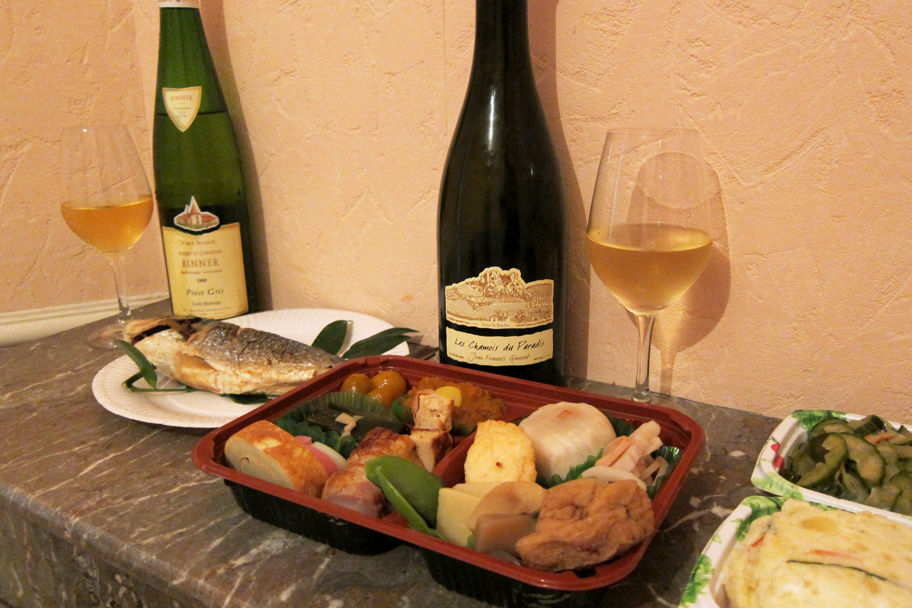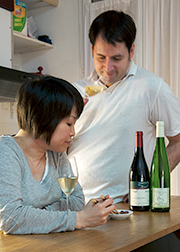Osechi is a traditional Japanese set of dishes which is prepared for the new year festivities. Usually presented in bento-type boxes which are stacked on top of each other, typical osechi are foods which are pre-cooked and eaten cold over the first three days of the year, a period during which the women of the house are busy entertaining family members and guests, leaving little time for preparing meals.
While Mizuki and I don’t particularly care for the typical osechi dishes, we decided to order one from a bento specialist in the Japanese district here in Paris. Having just moved into our apartment, and with little in terms of cooking equipment, we figured it would be a good excuse to try it out with some specially chosen wines!
I decided to go for a mature Alsatian Pinot Gris, a white wine with enough residual sugar to go up against the relatively sweet dishes, from the sweetened omelet (datemaki) to the sweet potato and chestnut purée (kurikinton). The wine was a 1998 vintage from the Binner estate, and presented quite a bit of sugar actually, with ripe fruit aromas along with interesting petrol-like notes. Unfortunately, while it matched the weight and intensity of the datemaki, it offered little excitement beyond that. I think a slightly less exuberant demi-sec (Vouvray?) might work better.
As for the kurikinton, the Pinot Gris actually felt a bit too lean, loosing out to the sweet purée. This one requires at least a moelleux I think. A Sauternes, or other oaked dessert wine such as the Italian Vino Santo might be a good option. The best match for the Pinot Gris might have actually been the sweet kumquats, or kinkan, but a younger version would have resonated even more nicely with the bright fruit flavors.
The only complete disaster as far as pairings was the Pinot Gris with the grilled tai, or snapper. It really brought out fishy tastes and was absolutely horrendous. The Jura didn’t particularly shine with the fish either, but at least they didn’t clash. Which brings us to the other wine of the day: Côtes du Jura 2009 “Chamois du Paradis” by Domaine Ganevat. This is a top natural wine producer of the Jura region, and this no-sulfite-added Chardonnay was a real beauty, with a great minerality.
In this context, I was expecting the rustic aromas of this natural wine to go well with the various root flavors, such as the renkon (lotus root), takenoko (bamboo shoot), kikunohana (pickled turnip) or the konyaku. Again, the balance worked in most cases, but nothing really stood out as being particularly successful. A bit of a disappointment actually, especially after the amazing pairing of the previous evening between this Jura and whelk shellfish.
Turning to the seafood, the kombu seaweed or extremely bitter kazunoko (herring roe) didn’t fare any better, although the shrimp-flavored fish cake did bring a nice touch to the wine, showing off its minerality. Again, on the previous evening, the boiled shrimp (which is usually also included in osechi) worked well with the Jura, though it did bring out an oaky character which is hardly perceptible otherwise.
Overall, the meal was quite a disappointment. Nothing really stood out, and the wines weren’t really in their element. The right strategy might be to opt for a very versatile wine, such as a fino sherry, or a sparkler with a relatively high dosage. I’ll probably just give up however and leave the experimenting to you next year! I’ll be enjoying some sashimi instead!







